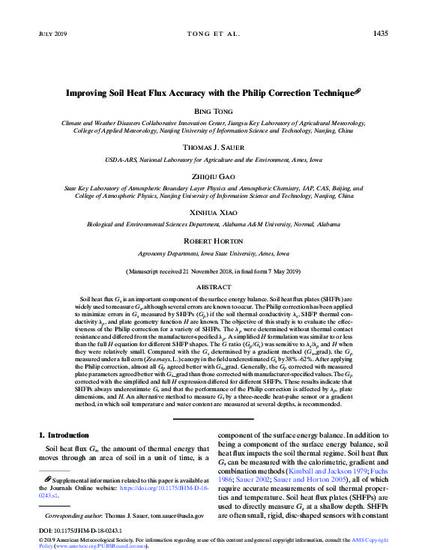
Soil heat flux Gs is an important component of the surface energy balance. Soil heat flux plates (SHFPs) are widely used to measure Gs, although several errors are known to occur. The Philip correction has been applied to minimize errors in Gs measured by SHFPs (Gp) if the soil thermal conductivity λs, SHFP thermal conductivity λp, and plate geometry function H are known. The objective of this study is to evaluate the effectiveness of the Philip correction for a variety of SHFPs. The λp were determined without thermal contact resistance and differed from the manufacturer-specified λp. A simplified H formulation was similar to or less than the full H equation for different SHFP shapes. The G ratio (Gp/Gs) was sensitive to λs/λp and H when they were relatively small. Compared with the Gs determined by a gradient method (Gs_grad), the Gpmeasured under a full corn (Zea mays, L.) canopy in the field underestimated Gs by 38%–62%. After applying the Philip correction, almost all Gp agreed better with Gs_grad. Generally, the Gp corrected with measured plate parameters agreed better with Gs_grad than those corrected with manufacturer-specified values. The Gp corrected with the simplified and full H expression differed for different SHFPs. These results indicate that SHFPs always underestimate Gs and that the performance of the Philip correction is affected by λp, plate dimensions, and H. An alternative method to measure Gs by a three-needle heat-pulse sensor or a gradient method, in which soil temperature and water content are measured at several depths, is recommended.
Available at: http://works.bepress.com/robert-horton/131/

This article is published as Tong, Bing, Thomas J. Sauer, Zhiqiu Gao, Xinhua Xiao, and Robert Horton. "Improving Soil Heat Flux Accuracy with the Philip Correction Technique." Journal of Hydrometeorology 20 (2019). doi: 10.1175/JHM-D-18-0243.1.